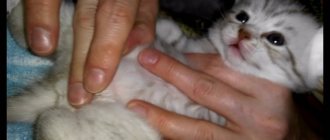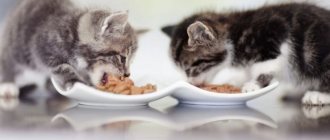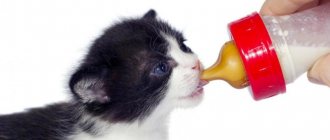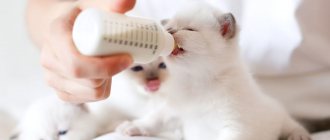March 2, 2019
How many grams of dry food does a kitten need, how often to fill the bowl and how to tell if the baby is full - in this article we will try to answer the questions that worry many owners. And this is not surprising, because kittens grow quickly, and their food needs change just as quickly.
The owner needs to be well versed in the norms so that the baby receives the right amount of nutrition and does not lag behind in development. But first you need to understand whether it is developing correctly.
How much does a kitten weigh?
Gradual and sufficient weight gain is the main indicator of proper development. If you know the age and breed of the kitten, just weigh it on the scale.
It is advisable to weigh kittens weighing up to 1 kg on electronic kitchen scales that have a small error. To do this, use either a special container that comes with the scales, or a suitable plastic container.
Larger pets can also be weighed on household floor scales. As a last resort, you can weigh yourself, and then with your pet in your arms - and calculate the difference.
It is believed that until the age of six months, a kitten gains, on average, 100 grams of weight per week. After 6 months, the growth of a kitten of most breeds almost stops, but the weight continues to increase due to an increase in muscle mass.
However, there are breed characteristics - for example, Maine Coons grow very slowly and only by two years, or even later, gain their final weight and height. So for more accurate information, it is better to contact the breeder or a specialized website for the breed.
Here is a table showing the approximate weight parameters of kittens of different breeds by month. You can focus on it when determining the norm of development of a kitten.
Kitten weight table
| Development of kittens in the first year of life | ||||||
| Age | Weight of cats, g | Cats weight, g | ||||
| average | big | very large | average | big | very large | |
| 4 weeks | 550 | 630 | 820 | 450 | 560 | 740 |
| 6-8 weeks | 1000 | 1230 | 1500 | 900 | 1150 | 1400 |
| 10-12 weeks | 1350 | 1800 | 2300 | 1200 | 1700 | 2300 |
| 14-16 weeks | 1700 | 2700 | 3800 | 1500 | 2600 | 3600 |
| 5 months | 2050 | 3200 | 5500 | 1800 | 2900 | 4300 |
| 6 months | 2400 | 3900 | 6000 | 2100 | 3200 | 4500 |
| 7 months | 2750 | 4200 | 6500 | 2400 | 3500 | 4900 |
| 8 months | 3100 | 4500 | 6900 | 2700 | 3800 | 5200 |
| 9 months | 3450 | 5000 | 7000 | 3000 | 4100 | 5500 |
| 10 months | 3800 | 5200 | 7700 | 3200 | 4200 | 5800 |
| 11 months | 4050 | 2600 | 8000 | 3350 | 4300 | 6100 |
| 12 months | 4500 | 5700 | 9000 | 3500 | 4500 | 6800 |
| 18 months | 6000 | 9500 | 4700 | 7000 | ||
Where to start complementary feeding at 6 months of age: single-ingredient products
At the age of 4 to 6 months, introduction to complementary foods begins with one-ingredient dairy-free cereals or vegetable purees. In the first case, gluten-free baby porridges are recommended - buckwheat or rice, and a little later corn.
If the pediatrician recommends starting with vegetable purees, they should also be one-component. You can introduce your baby to baby zucchini purees, broccoli or cauliflower.
It is recommended to use industrially produced products in the nutrition of young children. Such products undergo strict quality control and have a consistency that is necessary for the baby.
Fruit purees are introduced into the diet later, when the baby becomes familiar with vegetable, meat purees and baby cereals. To ensure that your child develops correct eating habits, be sure to consult a specialist. It is best if parents adhere to the principles of rational nutrition themselves and instill similar habits in their child from early childhood.
How do you know how much food to give your kitten?
Dry kitten food packaging usually lists recommended daily amounts based on their age and weight. Here is an example of a feeding table for our Blitz turkey product for kittens. It is worth remembering that these standards are approximate and do not take into account the individual characteristics of the pet.
| Kitten weight | Kitten age (in weeks) | |||
| 20-29 | 30-39 | 40-52 | ||
| up to 4 months | 4-7 months | 7-10 months | 10-12 months | |
| (kg) | Norm per day | |||
| 0.5 kg | 24 g | |||
| 1 kg | 48 g | 32 g | ||
| 2 kg | 97 g | 63 g | 48 g | |
| 3 kg | 145 g | 95 g | 72 g | 56 g |
| 4 kg | 120 g | 97 g | 74 g | |
| 5 kg | 121 g | 93 g | ||
| 6 kg | 111 g | |||
Please note that a baby will need only about 48 grams of food per 1 kilogram of weight per day, and this small amount will be enough to fully cover the costs of a growing body.
As the kitten grows, food consumption per kilogram of body weight gradually decreases, which is associated with lower energy consumption by the body. So, from 4.5–5 months the pet is given 32 grams of food per 1 kg of its weight, and starting from 7 months - 24 grams.
To easily determine the required portion of food, you will need a measuring cup. You can ask for it at a pet store or make it yourself. To do this, take a transparent plastic glass and weigh 10 grams of food in it sequentially, marking the content level with a marker. It is enough to make 10 notes, which will correspond to 100 g of food - you are unlikely to need more.
Useful tips
Among other things, you can give some more useful tips on feeding cats:
- If there are several pets in the house that require different diets, feed them separately from each other.
- Be sure to combine wet food with dry food - when chewed, it cleans the teeth of plaque.
- If in the summer heat your cat refuses to eat, but in the fall, on the contrary, eats with excessive appetite, this is normal. Don’t be alarmed, this is how the animal reacts to the changing seasons.
- Cat food should be stored like human food, i.e. observing all sanitary measures.
- Sometimes you can't be too strict. Observe which food your pet enjoys the most, and don’t be shy about pampering him.
- And one more prudent advice: do not start feeding the kitten from your table. To keep those big green eyes by your side for more than twenty years (this is a very realistic period for a pet), do not give him treats from your plate.
Adjustment of the norm
Let us remind you that you should pour food into a bowl once or twice a day strictly according to the norm and monitor how quickly the food runs out and whether the kitten shows signs of hunger. If you decide to give out food twice, do not forget to divide the daily amount into two parts.
When calculating the norm, you should also take into account the additional nutrition that the kitten receives - most often, these are various treats. They should make up no more than 10% of the total food volume.
Carefully monitor how much food your pet eats per day, because in the first year of a kitten’s life you will have to adjust feeding rates quite often due to the animal’s growth.
If the kitten has normal body condition and weight, then everything is fine and there is no need to adjust the norm. In all other cases, it is necessary to increase or decrease the norm, since underfeeding and overfeeding a baby can affect the health and longevity of an adult animal.
Water in a cat's diet
It is worth making sure that your pet's bowl is always filled with water. Especially if the cat eats dry food. Firstly, because the animal will naturally want to drink, and secondly, many foods contain salt, which makes the pet want to drink even more.
There is no need to force your pet to drink. You should not use existing myths on your animal about the need to “pour” water into the cat’s mouth from a syringe. Pour water into a bowl and your cat will drink as much as she needs.
Knowing the norms, the owner will correctly calculate how many bags of food to give the cat per day. Treat your pet's nutrition responsibly, and he will be healthy!
Please share the article online or send it via messenger. This will greatly help in the development of the site.











